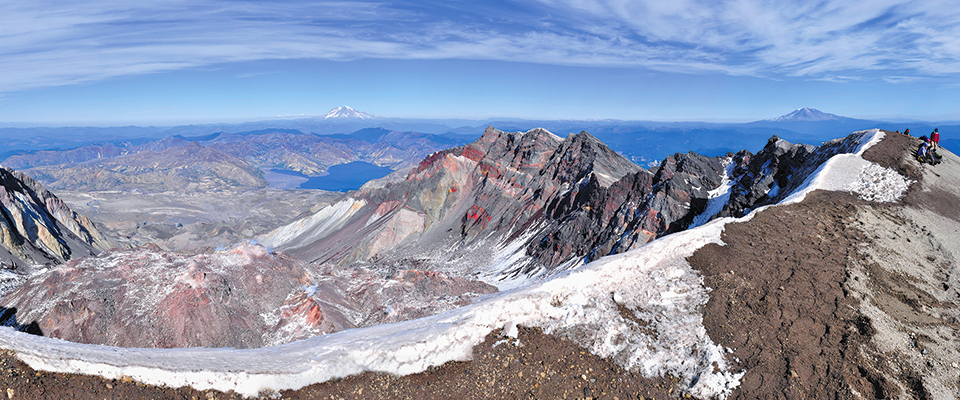Spotlight: Mount Rainier & Mount St. Helens
Washington’s two iconic peaks lure explorers with unforgettable trails
Visible from Seattle, Washington state’s fabled Cascade Range comprises an 800-mile line of volcanoes that stretches from British Columbia to the tip of California. Formed from plate tectonics, some of the most powerful stratovolcanoes (tall, perfect cone volcanoes formed over centuries by layers of volcanic material) on earth can be found here: Mount Baker, Glacier Peak, Mount Rainier, Mount St. Helens and Mount Adams.
The Power and the Glory
In 1899, Mount Rainier became the nation’s fifth national park. Set off by its 26 glaciers, the hauntingly beautiful Rainier is inauspiciously deemed one of the world’s most dangerous volcanoes due to its monumental size, the tremendous volume of ice and snow draped over its cone and its proximity to large population centers. Steam vents that gust from the mountain’s peak suggest that while the volcano is currently dormant, the potential for an eruption should not be ignored. More reassuringly, scientists believe that Rainier’s volcanic activity only occurs every 3,000 years.

Getty Images/iStockphoto
Trails of the Unexpected
Given its seductive beauty and mythical aura, Mount Rainier has become a rite of passage for serious climbers. The first documented summit of Mount Rainier was made in 1870 by Gen. Hazard Stevens. Certainly, climbing the 14,409-foot volcano is not for the faint of heart; an estimated 9,000 climbers attempt to summit each year, and more than half of those fail. For lesser mortals, the mountain’s snow-capped peak and verdant lower foothills afford some 260 miles of hiking trails. If you have around two weeks to spare, the Wonderland Trail’s 93-mile loop circles Mount Rainier, passing through subalpine meadows, glacial streams, mountain passes and valley forests to an ultimate summit point of 6,500 feet at Panhandle Gap, which features some of the most awe-inspiring panoramas in the nation.
Despite the tourist onslaught during the summer, the best day hikes are Paradise and Sunrise alpine trails. At Paradise, the 5-mile Skyline Trail ascends through stunning meadows, while at Sunrise, the 5-mile Burroughs Mountain Trail and the 5 1/2-mile Mount Fremont Lookout Trail are scenic and afford wildlife-watching, most consistently in the form of mountain goats. If you are traveling with children, Rainier’s most idyllic low-elevation hike is the 1.5-mile Grove of the Patriarchs Trail that weaves through a stunning grove of 1,000-year-old red cedars on an island in the Ohanapecosh River. For those who prefer a window seat, it takes around 5 hours to drive around the mountain (147 miles). Mount Rainier is open year-round, but many mountain roads are closed during their winter season, Nov. 1-May 1. Enshrouded with the Pacific’s moisture-soaked air, Rainier’s glaciated slopes remain snow-capped year-round.
The Sound and the Fury
Lording over mystical forests, the picture-perfect volcano of Mount St Helens, 178 miles south of Seattle, instilled the nation with horror on May 18, 1980, when it erupted with a violence unprecedented in the modern era. The cataclysmic eruption blasted off the side of the volcano and spliced the top 1,300 feet off the peak to set off the largest landslide on record. The blast, which spewed out ash at 650 miles per hour, was heard hundreds of miles away with ash scattered as far away as Denver. Some 57 people lost their lives.

Getty Images/iStockphoto
Close Encounters
Mount St Helens has been preserved as Mount St. Helens National Volcanic Monument. Several visitor centers provide state-of-the-art interpretive exhibits that examine the causes of the eruption and the ongoing reforestation project. Chiseled into the mountainside, the Johnston Ridge Observatory, located at the blast zone just five miles from the crater, provides the best vantage point to behold the sputtering volcano.
The Mount St. Helens National Volcanic Monument forms part of the Gifford Pinchot National Forest. Within the park’s 1,368,300 acres, there are five high-altitude lakes within a 7-mile radius and 200 miles of hiking trails. These paths weave through meadows carpeted with wildflowers and berry fields, cross stunning river valleys and skirt St. Helens’ growing volcanic crater, Washington’s newest glacier. For wildlife watching, the areas of Lone Butte, Cayuse and Skookum Meadows are prime spots to view elk, deer, warblers and turtles.
Some of the best hiking trails in Gifford Pinchot include the Norway Pass to Mount Margaret (just over 10 miles round trip), which leads through wildflower fields to a ridge that offers jaw-dropping views of Rainier, Adams and Hood, as well as Mount St. Helens. A more challenging hike (narrow trails with steep drop-offs) to Harry’s Ridge (8 miles round trip) leaves from the Johnston Ridge Observatory and affords incredible views of the crater’s mouth along with Loowit Falls and an emerging glacier. On clear days, you can also see Spirit Lake, Mount Adams and Mount Hood. Along Eruption Trail, you can see the emerging lava dome and, heading east from the Johnston Ridge Observatory, the Boundary Ridge Trail provides surreal panoramas of the blast zone.
Going Ape
Follow the blazing trail of searing magma by exploring Ape Cave Lava Tube, one of the most popular attractions in Mount St. Helens National Monument. At more than two miles in length, Ape Cave is considered the longest lava tube in the continental United States. Ape Cave is located on the south side of the mountain and is accessible through Woodland.
For true spelunkers, nearby Lake Cave is harder to find but worth the trip. Parts of the underground chamber require crawling, so only serious explorers should consider entering this challenging space.
If you prefer treetop adventure to subterranean trails, drop in on Mount St. Helens Zipline Adventures. Located in Silver Lake, this attraction allows adventure-seekers to strap into harnesses and zip along lines strung between immense trees. When you’re done speeding under the forest canopy, enjoy views of the mountain from Treehouse Island, with roomy observation decks that dish out spectacular views of the forest and beyond.
For More Information






